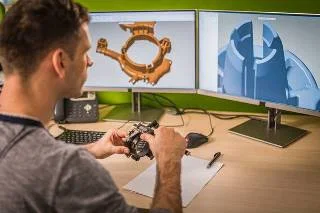Tinkercad
TinkerCad is a free, online 3D modeling program
that runs in a web browser, known for its simplicity and ease of use. Since it
became available in 2011, it has become a popular platform for creating models
for 3D printing as well as an entry-level introduction to constructive solid
geometry in schools.
Tinkercad
was founded in 2011 by
former Google engineer Kai Beckman and his co-founder Mikko Mononen in the
European Union as a creative commons license to the general public for 3D
modeling, especially for designing physical items. In 2011, the Tinkercad.com
website was launched as a web-based 3D modeling tool for WebGL-enabled
browsers, and in 2012 the company moved its headquarters to San Francisco. By
2012, 100,000 3D designs had been published by users. In March 2017, Autodesk
recommended that users of the soon-to-be-retired 123D sculptors move to TinkerCad.
The main features of Tinkercad
Although
TinkerCad is suitable for beginners, this does not mean that those who
are more experienced with 3D modeling will not appreciate this software. It is
based on CSG to create solid models; you can always complicate your model by
adding more sizes. In addition, the software enables the addition of electronic
circuits in 3D design to create objects with light and movement. The end result
can even be simulated in software to test how the components will react in real
life. Another ability of TinkerCad is to transform a 3D design into a buildable
brick model, similar to creating legos. Ultimately, you'll be better served for
those who love Minecraft, because you'll be able to get creative with the app.
Therefore,
TinkerCad can be used for a variety of applications, including 3D printing. 3D
models can be saved in three separate formats, STL, OBJ, and SVG. Once your
model has an STL file, you can use slicing software. The slicing software
converts the 3D model into a series of thin layers and produces a G-code file
that keeps the instructions according to the specific printer. In other words,
it splits the object into a stack of plane layers and describes these layers as
the linear motion of a 3D printer extruder.
Users
often appreciate how intuitive this CAD software is. Transformation,
duplication, and reshaping can be easily realized. Additionally, Autodesk has
provided a lot of resources to its community. For example, you'll find
inspiration and tips and tricks for getting started on their blog, as well as
videos! You can find more information on their website.
How do I 3D print by Tinkercad
There
are several different ways you can print 3D from Tinkercad. If you have a
printer at home or at a local manufacturer's location, download the STL file
from your dashboard by clicking the model thumbnail or from within the editor.
Just click Design> Download for 3D printing. STL is the standard file for
most single-color printers, so get started. If you do color printing, just
confirm the size of the model on TinkerCad before going to the printing
services.
Tinkercad
export option
It's
easy to export a design from TinkerCad for viewing, creating, or sharing. When
you click "Export", you have several options for the layout where you
will export your design.
STL
Universal
format for 3D printing. Choose STL format if you are exporting for 3D printing.
The STL format is supported by many other software packages; It is widely used
for rapid prototyping, 3D printing, and computer-aided manufacturing.
OBJ
OBJ
is an open format commonly used in 3D graphics applications. Use OBJ format for
multi-color 3D printing. OBJ format export from Tinkercad creates a zip file
that contains two files. One file describes the geometry (example.obj) and the
other the colors (example.mtl).
GLTF
Also
written as a GLTF format, this export option reduces both the size and runtime
processing of 3D resources and those resources needed to unpack and use. GLTF
is becoming increasingly popular for digital sharing and workflow viewing, such
as SketchFab or Facebook.
USDZ
(iPad app only)
USDZ
is a 3D file format that appears as 3D or AR content in the native Tinkercad
iOS app for the iPad. Export this format from the TinkerCad iPad app, then send
it to Mail, Messages, and other built-in iOS applications.
SVG
SVG is a vector image format for two-dimensional graphics. For example, use this format for laser cutting projects. When exporting this type from TinkerCad, a 2D vector is created where the 3D model intersects the default workspace.











0 Comments